Formic Acid Market
Formic Acid Market Size and Share Forecast Outlook 2025 to 2035
Formic acid market is projected to grow from USD 1.9 billion in 2025 to USD 2.7 billion by 2035, at a CAGR of 3.6%. 85–94% will dominate with a 58.0% market share, while silage & animal nutrition will lead the application segment with a 37.0% share.
Formic Acid Market Forecast and Outlook 2025 to 2035
The global formic acid market is valued at USD 1.9 billion in 2025. It is slated to reach USD 2.7 billion by 2035, recording an absolute increase of USD 0.8 billion over the forecast period. This translates into a total growth of 42.1%, with the market forecast to expand at a CAGR of 3.6% between 2025 and 2035.
The overall market size is expected to grow by nearly 1.42X during the same period, supported by increasing animal feed preservation demand, growing leather processing applications, and rising adoption of formic acid in chemical synthesis and de-icing applications across diverse agricultural, industrial, and chemical processing sectors.
Quick Stats for Formic Acid Market
- Formic Acid Market Value (2025): USD 1.9 billion
- Formic Acid Market Forecast Value (2035): USD 2.7 billion
- Formic Acid Market Forecast CAGR: 3.6%
- Leading Concentration in Formic Acid Market: 85–94%
- Key Growth Regions in Formic Acid Market: North America, Europe, and Asia Pacific
- Key Players in Formic Acid Market: BASF, LUXI Chemical, Perstorp, Eastman Chemical, Feicheng Acid Chemical, Tanfac Industries
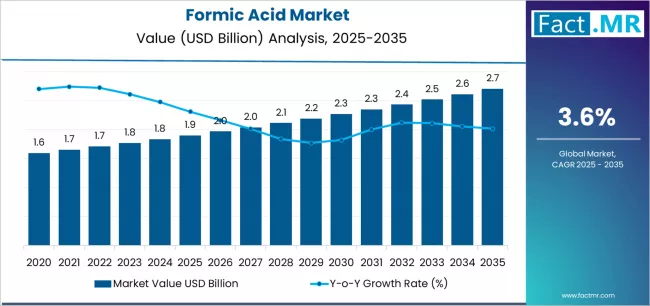
Formic acid’s versatility across multiple industries continues to support its steady market expansion. In the agricultural sector, the compound is primarily used as a feed additive to enhance preservation and inhibit microbial growth in silage. Its ability to lower pH and provide antimicrobial effects makes it highly effective in improving livestock nutrition, which is critical for meeting the growing global demand for animal protein. Additionally, the chemical’s role in leather processing as a tanning and finishing agent has been expanding, particularly with the industry’s focus on improving quality while maintaining environmentally compliant processing methods.
In industrial and chemical applications, formic acid serves as an intermediate in the production of leather auxiliaries, textiles, rubber, and dyes. Its utility in de-icing operations, particularly for airport runways and industrial machinery, is gaining attention as safety standards tighten and the need for efficient, biodegradable alternatives grows. Moreover, emerging applications in pharmaceuticals, hydrogen storage, and bio-based chemicals are creating niche opportunities. Research into formic acid’s potential as a hydrogen carrier, for instance, positions it as a key chemical in the transition toward renewable energy sources.
Technological advancements are reshaping the formic acid market landscape. Process improvements in carbon monoxide-based synthesis and the development of bio-based production pathways from biomass are driving higher efficiency, lower costs, and improved environmental profiles. Companies adopting green synthesis methods are likely to gain a competitive advantage by meeting increasingly stringent environmental regulations while appealing to sustainability-conscious end users.
Supply chain innovations are also influencing market dynamics. Strategic partnerships with raw material suppliers, optimized logistics networks, and localized production facilities are helping manufacturers ensure consistent quality and timely delivery to industrial, agricultural, and chemical sectors. The integration of digital monitoring and process control systems is enhancing operational efficiency and reducing the risk of supply disruptions, which is especially crucial for industries reliant on continuous chemical feedstock availability.
Regulatory oversight continues to play a pivotal role. Compliance with chemical handling and storage regulations, along with restrictions on emissions and effluents, influences production processes, pricing, and distribution. Companies that proactively align with safety standards and environmental norms are better positioned to capture long-term growth opportunities.
Between 2025 and 2030, the formic acid market is projected to expand from USD 1.9 billion to USD 2.3 billion, resulting in a value increase of USD 0.4 billion, which represents 50.0% of the total forecast growth for the decade. This phase of development will be shaped by increasing animal nutrition applications, rising leather processing demand, and growing chemical synthesis requirements.
Chemical manufacturers and agricultural solution providers are expanding their formic acid production capabilities to address the growing demand for versatile and effective organic acid solutions that ensure preservation efficacy and processing performance.
Formic Acid Market Key Takeaways
| Metric | Value |
|---|---|
| Estimated Value in (2025E) | USD 1.9 billion |
| Forecast Value in (2035F) | USD 2.7 billion |
| Forecast CAGR (2025 to 2035) | 3.6% |
From 2030 to 2035, the market is forecast to grow from USD 2.3 billion to USD 2.7 billion, adding another USD 0.4 billion, which constitutes 50.0% of the overall ten-year expansion. This period is expected to be characterized by the expansion of sustainable production methods, the development of bio-based formic acid technologies, and the growth of specialized applications for green chemistry and renewable energy storage systems. The growing adoption of environmentally friendly production processes and circular economy principles will drive demand for formic acid with enhanced sustainability credentials and reduced environmental impact.
Between 2020 and 2025, the formic acid market experienced steady growth, driven by increasing animal feed preservation requirements and growing recognition of formic acid as an essential organic compound for enhancing preservation effectiveness and enabling diverse industrial applications across agricultural, leather processing, and chemical manufacturing sectors. The market developed as manufacturers recognized the potential for formic acid technology to provide antimicrobial benefits, support pH control applications, and facilitate chemical synthesis processes while meeting stringent safety and environmental requirements. Technological advancement in production efficiency and purification methods began emphasizing the critical importance of maintaining product quality and cost-effectiveness in challenging market environments.
Why is the Formic Acid Market Growing?
Market expansion is being supported by the increasing global demand for animal feed preservation driven by livestock industry growth and food safety requirements, alongside the corresponding need for effective organic acid solutions that can enhance feed quality, enable antimicrobial protection, and maintain nutritional value across various agricultural, industrial, chemical processing, and de-icing applications. Modern agricultural and chemical companies are increasingly focused on implementing formic acid solutions that can provide preservation effectiveness, support regulatory compliance, and ensure operational efficiency while meeting comprehensive safety and environmental standards.
The growing emphasis on sustainable agriculture and food safety is driving demand for formic acid that can support organic farming approaches, enable natural preservation methods, and ensure comprehensive animal health protection. Agricultural producers' preference for preservation solutions that combine effectiveness with environmental compatibility and regulatory compliance is creating opportunities for innovative formic acid implementations. The rising influence of leather industry expansion and chemical synthesis applications is also contributing to increased adoption of formic acid solutions that can provide processing benefits without compromising product quality or environmental responsibility.
Segmental Analysis
The market is segmented by concentration, application, and process. By concentration, the market is divided into 85-94%, >94%, and <85% grades. Based on application, the market is categorized into silage & animal nutrition, leather & textiles, and chemicals & de-icing. By process, the market includes carbonylation and oxidation of hydrocarbons. Regionally, the market is divided into North America, Europe, Asia Pacific, Latin America, and Middle East & Africa.
By Concentration, the 85-94% Segment Leads the Market
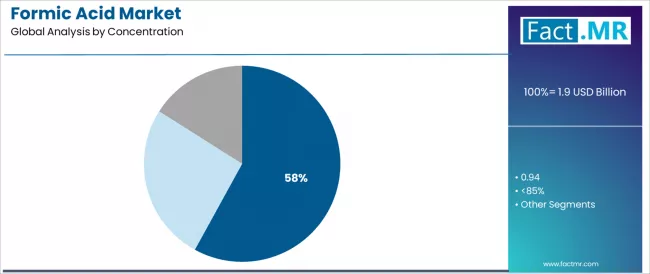
The 85-94% concentration segment is projected to maintain its leading position in the formic acid market in 2025 with a 58.0% market share, reaffirming its role as the preferred concentration range for industrial applications and commercial processing requirements. Chemical manufacturers and agricultural solution providers increasingly utilize 85-94% formic acid for its optimal balance of effectiveness and handling safety, proven performance reliability, and established cost-effectiveness in diverse preservation and processing applications. This concentration range's proven versatility and application effectiveness directly address the industry requirements for reliable organic acid solutions and comprehensive industrial processing across diverse market segments and operational conditions.
This concentration segment forms the foundation of modern formic acid applications, as it represents the grade with the greatest contribution to industrial utility and established commercial acceptance across multiple application areas and processing environments. Industrial investments in formic acid processing and application technologies continue to strengthen adoption among manufacturers and solution providers. With growing demands for cost-effective processing solutions and regulatory compliance, 85-94% concentration formic acid aligns with both performance requirements and operational efficiency objectives, making it the central component of comprehensive organic acid utilization strategies.
By Application, the Silage & Animal Nutrition Segment Dominates Market Demand
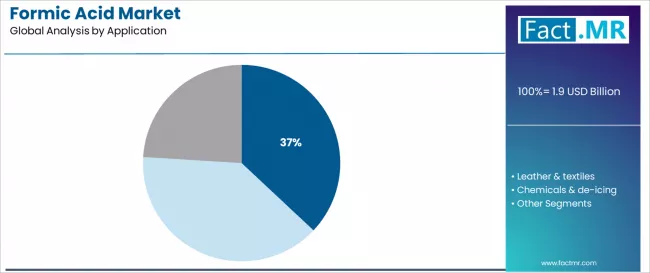
The silage & animal nutrition application segment is projected to represent the largest share of formic acid demand in 2025 with a 37.0% market share, underscoring its critical role as the primary driver for formic acid adoption across animal feed preservation, silage quality enhancement, and livestock nutrition applications. Agricultural producers prefer formic acid for its proven antimicrobial effectiveness, established feed preservation benefits, and ability to enhance feed digestibility while supporting animal health and regulatory compliance. Positioned as essential solutions for modern agricultural operations, formic acid offers both preservation advantages and nutritional benefits.
The segment is supported by continuous innovation in animal nutrition technologies and the growing availability of specialized formic acid formulations that enable superior preservation performance with enhanced feed quality and nutritional optimization. Additionally, agricultural producers are investing in comprehensive feed preservation programs to support increasingly stringent food safety regulations and consumer demand for high-quality animal products. As livestock production intensifies and feed quality requirements increase, the silage & animal nutrition application will continue to dominate the market while supporting advanced formic acid utilization and agricultural optimization strategies.
What are the Drivers, Restraints, and Key Trends of the Formic Acid Market?
The formic acid market is advancing steadily due to increasing demand for animal feed preservation driven by livestock industry growth and growing adoption of sustainable agricultural practices that require effective organic acid solutions providing antimicrobial protection and pH control benefits across diverse agricultural, industrial, leather processing, and chemical synthesis applications.
However, the market faces challenges, including handling safety concerns and corrosive properties, competition from alternative preservation methods and organic acids, and supply chain constraints related to production capacity limitations and raw material availability. Innovation in production technologies and application development continues to influence product development and market expansion patterns.
Expansion of Sustainable Agriculture and Organic Farming Applications
The growing adoption of sustainable agriculture is driving demand for formic acid solutions that address organic farming requirements, support natural preservation methods, and provide environmentally friendly alternatives to synthetic preservation chemicals while maintaining feed quality and animal health standards. Organic farmers require formic acid products that deliver reliable preservation performance with certified organic compliance and minimal environmental impact.
Agricultural companies are increasingly recognizing the competitive advantages of formic acid integration for sustainable farming practices and organic certification requirements, creating opportunities for specialized formulations designed for organic agriculture and environmentally conscious livestock production.
Integration of Bio-Based Production and Green Chemistry Technologies
Modern formic acid producers are incorporating renewable feedstock utilization and green chemistry principles to enhance environmental sustainability, reduce carbon footprint, and support comprehensive circular economy objectives through optimized production processes and biotechnology applications.
Leading companies are developing bio-based production methods, implementing carbon capture utilization technologies, and advancing fermentation processes that minimize environmental impact while maintaining product quality and cost competitiveness.
These technologies improve environmental credentials while enabling new market opportunities, including sustainable chemical synthesis, green energy applications, and environmentally conscious industrial processes. Advanced sustainability integration also allows producers to support comprehensive environmental compliance objectives and market differentiation beyond traditional cost and performance considerations.
Development of Energy Storage and Renewable Energy Applications
The expansion of renewable energy systems and energy storage requirements is driving demand for formic acid applications in hydrogen storage, fuel cell technologies, and energy conversion systems that exceed traditional industrial and agricultural applications.
These advanced applications require high-purity formic acid with specialized handling systems and enhanced safety protocols, creating premium market segments with differentiated value propositions. Manufacturers are investing in purification technologies and specialized production capabilities to serve emerging energy applications while supporting innovation in renewable energy storage and conversion technologies.
Analysis of the Formic Acid Market by Key Countries
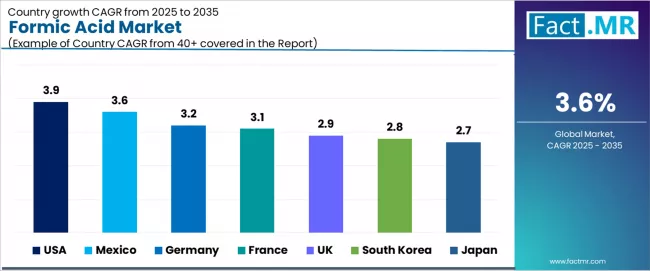
| Country | CAGR (2025-2035) |
|---|---|
| USA | 3.9% |
| Mexico | 3.6% |
| Germany | 3.2% |
| France | 3.1% |
| UK | 2.9% |
| South Korea | 2.8% |
| Japan | 2.7% |
The formic acid market is experiencing solid growth globally, with the USA leading at a 3.9% CAGR through 2035, driven by expanding livestock industry, growing leather processing applications, and increasing chemical synthesis demand supported by comprehensive industrial infrastructure and agricultural modernization. Mexico follows at 3.6%, supported by rapid agricultural development, expanding livestock production, and growing industrial processing capabilities.
Germany shows growth at 3.2%, emphasizing chemical industry excellence, sustainable production technologies, and advanced industrial applications. France demonstrates 3.1% growth, supported by agricultural leadership, chemical manufacturing capabilities, and environmental sustainability initiatives.
The UK records 2.9%, focusing on agricultural modernization, chemical processing innovation, and sustainable production methods. South Korea exhibits 2.8% growth, emphasizing chemical industry development, advanced manufacturing capabilities, and industrial application expansion. Japan shows 2.7% growth, supported by precision chemical manufacturing, quality standards excellence, and advanced industrial processing technologies.
The report covers an in-depth analysis of 40+ countries; seven top-performing countries are highlighted below.
USA Leads Global Market Growth with Agricultural Innovation and Industrial Applications
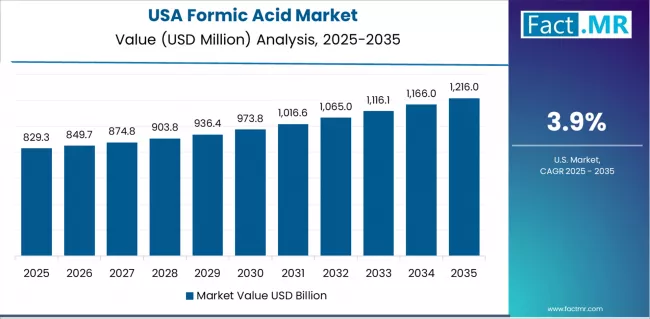
Revenue from formic acid in the USA is projected to exhibit exceptional growth with a CAGR of 3.9% through 2035, driven by expanding livestock industry and rapidly growing agricultural modernization supported by technological advancement and increasing investment in sustainable agricultural solutions.
The country's comprehensive agricultural infrastructure and increasing focus on feed quality optimization are creating substantial demand for effective organic acid solutions. Major agricultural companies and chemical manufacturers are establishing comprehensive formic acid production and application capabilities to serve both domestic markets and export opportunities.
- Growing livestock industry and intensive animal farming operations are driving demand for formic acid preservation solutions throughout major agricultural regions and livestock production facilities across feed manufacturers, agricultural cooperatives, and livestock operations.
- Strong chemical industry development and industrial processing expansion are supporting the adoption of formic acid technologies among manufacturers seeking reliable organic acid solutions for chemical synthesis and industrial processing applications.
- Advanced agricultural research and technology development capabilities are supporting formic acid innovation including application optimization, formulation improvement, and safety enhancement throughout major agricultural research institutions and corporate development centers.
- Expanding leather processing industry and textile manufacturing capabilities are driving demand for formic acid solutions supporting industrial processing requirements and quality enhancement across major manufacturing regions.
Mexico Demonstrates Strong Market Potential with Agricultural Development and Industrial Growth
Revenue from formic acid in Mexico is expanding at a CAGR of 3.6%, supported by rapid agricultural development, expanding livestock production, and growing industrial processing capabilities supporting formic acid integration across diverse agricultural and manufacturing applications. The country's expanding agricultural base and industrial modernization are driving sophisticated formic acid utilization throughout agricultural and chemical processing sectors. Leading agricultural companies and chemical manufacturers are establishing extensive formic acid production and distribution facilities.
- Rapid agricultural development and expanding livestock production are creating opportunities for formic acid adoption throughout major agricultural regions and livestock facilities serving domestic consumption and export markets.
- Growing industrial processing expansion and chemical manufacturing development are driving adoption of formic acid solutions among manufacturers seeking cost-effective organic acid alternatives for industrial applications and chemical synthesis.
- Strategic geographic advantages and trade relationship benefits are supporting formic acid market development including efficient distribution networks, competitive cost structures, and access to major North American markets.
- Expanding agricultural modernization programs and technology adoption initiatives are enabling advanced formic acid applications and processing capabilities throughout major agricultural production regions and industrial centers.
Germany Emphasizes Chemical Excellence with Sustainable Production and Industrial Innovation
Revenue from formic acid in Germany is expanding at a CAGR of 3.2%, supported by the country's chemical industry leadership, established sustainable production capabilities, and advanced industrial application development supporting high-quality formic acid solutions. Germany's chemical expertise and environmental focus are supporting investment in advanced formic acid production and application technologies. Major chemical companies and industrial manufacturers are establishing comprehensive development and quality assurance programs for formic acid applications.
- Advanced chemical industry expertise and precision manufacturing capabilities are creating demand for high-quality formic acid throughout major chemical processing centers and industrial manufacturing facilities emphasizing product quality and performance optimization.
- Strong environmental sustainability focus and green chemistry leadership are driving the development of sustainable formic acid production including renewable feedstock utilization and environmentally responsible manufacturing processes.
- Comprehensive research and development infrastructure and academic collaboration networks are advancing formic acid science including production optimization, application development, and environmental impact reduction throughout major research institutions and technology centers.
- Export market leadership and international quality reputation are enabling German formic acid producers to access global markets while maintaining premium positioning and technology advancement advantages.
France Shows Agricultural Leadership with Industrial Applications and Environmental Innovation
Revenue from formic acid in France is expanding at a CAGR of 3.1%, driven by agricultural industry strength, established chemical manufacturing capabilities, and comprehensive environmental sustainability initiatives supporting formic acid development in agricultural and industrial applications. The country's agricultural heritage and environmental consciousness are creating opportunities for sophisticated formic acid utilization. Leading agricultural companies and chemical manufacturers are establishing comprehensive sustainability programs incorporating environmental responsibility and operational efficiency.
- Strong agricultural industry and livestock production capabilities are creating demand for formic acid preservation solutions throughout major agricultural regions and livestock operations supporting feed quality enhancement and animal health optimization.
- Established chemical manufacturing expertise and industrial processing capabilities are supporting advanced formic acid applications including chemical synthesis, industrial processing, and specialty chemical production throughout major manufacturing centers.
- Comprehensive environmental sustainability initiatives and green chemistry development are advancing formic acid production including renewable energy integration, waste reduction programs, and circular economy implementation throughout manufacturing facilities.
- Premium food quality standards and agricultural excellence expectations are driving demand for high-quality formic acid solutions supporting livestock nutrition and agricultural product quality throughout major agricultural production regions.
UK Demonstrates Market Evolution with Agricultural Modernization and Chemical Innovation
Revenue from formic acid in the UK is expanding at a CAGR of 2.9%, supported by comprehensive agricultural modernization programs, established chemical processing capabilities, and growing environmental sustainability focus driving formic acid adoption across agricultural and industrial applications. The country's agricultural sophistication and regulatory framework are driving formic acid integration throughout diverse application sectors. Leading agricultural companies and chemical manufacturers are establishing comprehensive formic acid utilization strategies.
- Comprehensive agricultural modernization and livestock industry development are creating systematic market opportunities for formic acid throughout major agricultural regions and livestock operations emphasizing feed quality and animal health optimization.
- Growing environmental sustainability focus and green chemistry initiatives are supporting formic acid development including sustainable production methods, environmental impact reduction, and circular economy integration across manufacturing facilities.
- Advanced chemical processing capabilities and industrial innovation programs are enabling formic acid integration in challenging applications including specialty chemical synthesis and advanced industrial processing throughout major manufacturing centers.
- Innovation in agricultural technology applications and precision farming adoption is supporting formic acid utilization optimization including application efficiency improvement and performance enhancement throughout modern agricultural operations.
South Korea Emphasizes Chemical Industry Development with Manufacturing Excellence and Technology Integration
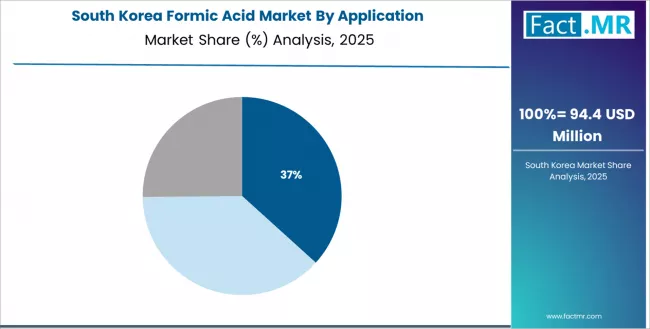
Revenue from formic acid in South Korea is expanding at a CAGR of 2.8%, supported by comprehensive chemical industry development, advanced manufacturing capabilities, and precision industrial applications emphasizing formic acid integration for performance enhancement and operational efficiency. The country's manufacturing excellence and technology focus are driving sophisticated formic acid utilization in chemical and industrial applications. Leading chemical manufacturers and industrial companies are establishing advanced formic acid processing and application capabilities.
- Comprehensive chemical industry development and manufacturing excellence are creating demand for formic acid solutions throughout major chemical processing centers and industrial manufacturing facilities emphasizing product quality and operational efficiency.
- Advanced manufacturing technologies and precision industrial capabilities are supporting formic acid integration in diverse applications including specialty chemical production, industrial processing, and advanced materials manufacturing.
- Technology innovation focus and research and development investment are advancing formic acid applications including processing optimization, quality enhancement, and specialized application development throughout major technology centers and research facilities.
- Export manufacturing strength and international market presence are enabling South Korean formic acid applications to serve global markets while maintaining quality standards and competitive positioning.
Japan Shows Quality Excellence with Precision Manufacturing and Advanced Applications
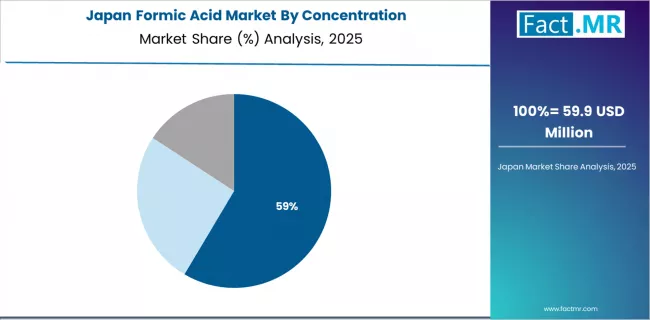
Revenue from formic acid in Japan is expanding at a CAGR of 2.7%, driven by exceptional chemical manufacturing standards, established precision processing capabilities, and advanced technology integration emphasizing superior formic acid quality and performance excellence. The country's commitment to manufacturing quality and technological advancement are creating opportunities for ultra-high-quality formic acid applications. Leading chemical manufacturers and precision processing companies are establishing comprehensive quality control and innovation programs.
- Exceptional chemical manufacturing standards and precision processing capabilities are creating demand for ultra-high-quality formic acid meeting Japanese industrial requirements for chemical purity and performance consistency.
- Advanced technology integration and innovation excellence are supporting formic acid application optimization including processing enhancement, quality improvement, and specialized application development throughout major manufacturing facilities.
- Comprehensive quality control systems and rigorous performance standards are ensuring superior formic acid consistency and reliability throughout major chemical manufacturing regions and precision industrial applications.
- Premium manufacturing culture and continuous improvement focus are driving demand for formic acid solutions that combine performance excellence with environmental responsibility and sustainable manufacturing practices.
Europe Market Split by Countries
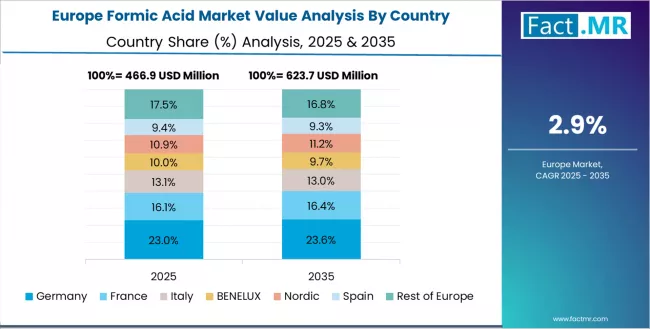
The formic acid market in Europe is projected to grow from USD 532.0 million in 2025 to USD 756.0 million by 2035, registering a CAGR of 3.6% over the forecast period. Germany is expected to maintain leadership with a 28.5% market share in 2025, moderating to 28.2% by 2035, supported by chemical industry excellence, sustainable production capabilities, and advanced industrial applications.
France follows with 19.5% in 2025, projected at 19.7% by 2035, driven by agricultural industry strength, chemical manufacturing capabilities, and environmental sustainability initiatives. The United Kingdom holds 16.0% in 2025, expected to reach 16.2% by 2035 on the back of agricultural modernization and chemical processing innovation. Italy commands 13.6% in 2025, rising slightly to 13.6% by 2035, while Spain accounts for 11.0% in 2025, reaching 11.2% by 2035 aided by agricultural development and industrial expansion.
The Netherlands maintains 5.5% in 2025, up to 5.6% by 2035 due to chemical processing expertise and agricultural innovation. The Rest of Europe region, including Nordic countries, Central & Eastern Europe, and other markets, is anticipated to hold 6.0% in 2025 and 5.5% by 2035, reflecting steady growth in agricultural modernization and chemical industry development.
Competitive Landscape of the Formic Acid Market
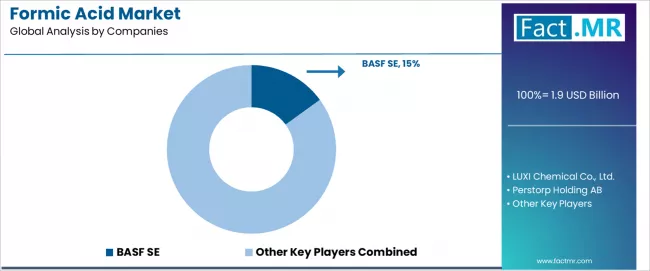
The formic acid market is characterized by competition among established chemical manufacturers, specialty acid producers, and integrated chemical companies. Companies are investing in production technology development, capacity expansion programs, sustainability initiatives, and application-specific solution development to deliver cost-effective, reliable, and environmentally responsible formic acid solutions. Innovation in production efficiency, purification technologies, and sustainable manufacturing practices is central to strengthening market position and competitive advantage.
BASF leads the market with a 15.0% share, offering comprehensive formic acid solutions with a focus on production excellence, application development, and sustainability integration across diverse agricultural, industrial, and chemical processing sectors.
The company has announced major production capacity expansions across European and Asian facilities, with plans to incorporate renewable feedstock utilization and advanced purification systems, with facility upgrades initiated in 2024 and enhanced production capabilities planned for 2026.
LUXI Chemical provides innovative formic acid solutions with emphasis on cost-effectiveness and production efficiency, having advanced their manufacturing strategy by expanding production capacity and developing specialized grade offerings for specific market applications.
Perstorp delivers high-performance formic acid products with focus on specialty applications and technical support services. Eastman Chemical offers comprehensive formic acid solutions with emphasis on quality consistency and customer service. Feicheng Acid Chemical specializes in formic acid production and processing technologies. Tanfac Industries focuses on formic acid manufacturing and application development.
Gujarat Narmada Valley Fertilizers & Chemicals provides formic acid solutions for agricultural applications. LCY Chemical offers formic acid products for industrial and chemical applications. Kemira delivers formic acid solutions for diverse market segments. Shijiazhuang Yulong Chemical provides formic acid manufacturing capabilities serving regional and global markets.
Formic Acid Market - Stakeholder Contribution Framework
Formic acid represents a versatile organic compound segment within agricultural, industrial, and chemical processing applications, projected to grow from USD 1.9 billion in 2025 to USD 2.7 billion by 2035 at a 3.6% CAGR.
These organic acid products—primarily in various concentration grades—serve as critical processing materials in animal nutrition, leather processing, chemical synthesis, and industrial applications where preservation effectiveness, pH control, and chemical reactivity are essential.
Market expansion is driven by increasing livestock production, growing leather processing demand, expanding chemical synthesis applications, and rising adoption of sustainable agricultural practices across diverse agricultural and industrial segments.
How Regulatory Authorities Could Strengthen Safety Standards and Market Development
- Handling Safety and Storage Regulations: Establish comprehensive safety protocols for formic acid handling, storage, and transportation including ventilation requirements, protective equipment standards, and emergency response procedures that ensure worker safety while enabling efficient industrial utilization and distribution operations.
- Environmental Impact and Emissions Control: Develop stringent environmental regulations for formic acid production including air quality standards, wastewater treatment requirements, and waste management protocols that minimize environmental impact while supporting sustainable manufacturing practices and community protection.
- Food Safety and Agricultural Applications: Create specialized guidelines for formic acid use in animal nutrition including maximum residue limits, application procedures, and withdrawal period requirements that ensure food safety while enabling effective feed preservation and animal health management.
- Chemical Safety and Industrial Applications: Implement comprehensive chemical safety standards for formic acid industrial applications including exposure limits, handling procedures, and safety equipment requirements that protect workers while enabling diverse industrial and chemical processing applications.
- International Trade and Quality Standards: Facilitate global regulatory harmonization for formic acid including quality specifications, testing methodology standardization, and trade facilitation agreements that support international market access while maintaining high safety and quality standards.
How Agricultural Industry Associations Could Advance Best Practices and Application Development
- Feed Preservation and Animal Nutrition Guidelines: Develop comprehensive best practice manuals for formic acid applications in animal nutrition including dosage recommendations, application techniques, and storage procedures that maximize preservation effectiveness while ensuring animal health and feed quality optimization.
- Safety Training and Education Programs: Create specialized training initiatives for formic acid handling and application covering safety procedures, protective equipment usage, and emergency response protocols that enhance workplace safety while enabling effective agricultural utilization.
- Research and Development Collaboration: Facilitate partnerships between formic acid producers, agricultural researchers, feed manufacturers, and livestock producers to advance application techniques, optimize dosing protocols, and develop innovative preservation solutions that drive agricultural productivity and sustainability.
- Sustainability and Environmental Stewardship: Promote environmentally responsible formic acid applications including sustainable production practices, environmental impact minimization, and integrated pest management approaches that support agricultural sustainability while maintaining effectiveness and cost competitiveness.
- Quality Assurance and Certification Programs: Establish industry-wide quality standards and certification procedures including testing protocols, storage requirements, and application verification that ensure consistent product performance while supporting farmer confidence and market development.
How Formic Acid Manufacturers Could Drive Innovation and Market Leadership
- Production Technology Excellence: Invest in advanced manufacturing technologies including process optimization, yield improvement, and purification enhancement that increase production efficiency while reducing costs and environmental impact for competitive market positioning.
- Product Innovation and Specialized Formulations: Develop comprehensive formic acid product portfolios including concentration-specific grades, application-optimized formulations, and enhanced stability products that address diverse market needs while maintaining performance excellence and cost competitiveness.
- Sustainability and Environmental Responsibility: Implement sustainable production practices including renewable energy integration, waste minimization programs, and circular economy principles that reduce environmental footprint while supporting long-term supply chain sustainability and regulatory compliance.
- Customer Technical Support and Application Services: Establish comprehensive support capabilities including application assistance, technical troubleshooting, safety training, and optimization guidance that strengthen customer relationships while enabling successful product implementation and performance enhancement.
- Supply Chain Optimization and Global Distribution: Develop efficient distribution networks including strategic inventory management, logistics optimization, and customer service excellence that ensure reliable product availability while minimizing costs and supporting customer operational requirements worldwide.
How End-User Industries Could Optimize Formic Acid Applications and Performance
- Strategic Sourcing and Supplier Management: Develop comprehensive evaluation criteria for formic acid suppliers including quality specifications, safety compliance, technical support capabilities, and sustainability credentials that ensure optimal supplier selection while supporting long-term partnership success.
- Application Optimization and Best Practices: Implement systematic application procedures including dosage optimization, timing protocols, and storage management that maximize formic acid effectiveness while maintaining safety standards and cost efficiency throughout operational processes.
- Safety Management and Risk Mitigation: Establish comprehensive safety programs including worker training, protective equipment provision, and emergency response procedures that ensure workplace safety while enabling effective formic acid utilization and regulatory compliance.
- Quality Control and Performance Monitoring: Develop systematic testing and evaluation procedures for formic acid applications including incoming material inspection, process monitoring, and performance assessment that ensure consistent results while enabling continuous improvement and optimization.
- Innovation and Application Development: Explore innovative formic acid applications including process enhancement, efficiency improvement, and sustainability optimization that provide competitive advantages while addressing operational challenges and market differentiation opportunities.
How Research Institutions Could Advance Scientific Understanding and Technology Development
- Fundamental Chemistry Research: Conduct comprehensive studies investigating formic acid properties, reaction mechanisms, and application behavior that advance scientific knowledge while informing technology development and application optimization across diverse industrial and agricultural environments.
- Production Technology Innovation: Develop novel manufacturing methods including biotechnology applications, renewable feedstock utilization, and process intensification techniques that improve production efficiency while reducing environmental impact and manufacturing costs.
- Application Science and Performance Enhancement: Investigate formic acid behavior in complex systems including preservation mechanisms, chemical synthesis applications, and environmental interactions that enable optimized formulations while addressing performance challenges and application limitations.
- Environmental Impact and Sustainability Research: Study environmental effects of formic acid production and utilization including lifecycle assessment, biodegradation pathways, and ecological impact evaluation that support responsible industry development and environmental stewardship.
- Technology Transfer and Commercialization: Facilitate innovation development through industry partnerships, licensing programs, and collaborative research initiatives that accelerate technology adoption while strengthening industry-academia collaboration and commercial application development.
How Investment Community Could Support Market Growth and Innovation Excellence
- Production Capacity and Infrastructure Investment: Provide capital for formic acid manufacturing facility development, production equipment acquisition, and capacity expansion projects that address growing market demand while improving operational efficiency and environmental performance.
- Technology Development and Innovation Funding: Finance breakthrough production technologies, process optimization systems, and sustainability initiatives that enhance formic acid capabilities while creating competitive advantages and environmental benefits for long-term market success.
- Market Development and Geographic Expansion: Support market entry initiatives, distribution network development, and customer acquisition programs that increase market penetration while maintaining quality standards and operational excellence throughout expansion phases.
- Sustainability and Environmental Programs: Fund environmental responsibility initiatives including clean production technologies, renewable energy integration, and circular economy programs that address sustainability requirements while supporting regulatory compliance and market differentiation.
- Strategic Partnership and Integration Financing: Provide capital for strategic alliances, vertical integration initiatives, and technology acquisitions that strengthen market position while enabling access to new capabilities, markets, and technologies for comprehensive business development.
Key Players in the Formic Acid Market
- BASF SE
- LUXI Chemical Co., Ltd.
- Perstorp Holding AB
- Eastman Chemical Company
- Feicheng Acid Chemicals Co., Ltd.
- Tanfac Industries Limited
- Gujarat Narmada Valley Fertilizers & Chemicals Limited (GNFC)
- LCY Chemical Corp.
- Kemira Oyj
- Shijiazhuang Yulong Chemical Co., Ltd.
Scope of the Report
| Items | Values |
|---|---|
| Quantitative Units (2025) | USD 1.9 Billion |
| Concentration | 85–94%, >94%, <85% |
| Application | Silage & animal nutrition, Leather & textiles, Chemicals & de-icing |
| Process | Carbonylation, Oxidation of hydrocarbons |
| Regions Covered | North America, Europe, Asia Pacific, Latin America, Middle East & Africa |
| Countries Covered | USA, Mexico, Germany, France, UK, South Korea, Japan, and 40+ countries |
| Key Companies Profiled | BASF, LUXI Chemical, Perstorp, Eastman Chemical, Feicheng Acid Chemical, Tanfac Industries |
| Additional Attributes | Dollar sales by concentration and application category, regional demand trends, competitive landscape, technological advancements in production processes, sustainability development, bio-based production innovation, and application performance optimization |
Formic Acid Market by Segments
-
Concentration :
- 85–94%
- 94%
- <85%
-
Application :
- Silage & animal nutrition
- Leather & textiles
- Chemicals & de-icing
-
Process :
- Carbonylation
- Oxidation of hydrocarbons
-
Region :
-
North America
- United States
- Canada
- Mexico
-
Europe
- Germany
- United Kingdom
- France
- Italy
- Spain
- Netherlands
- Nordic
- Rest of Europe
-
Asia Pacific
- Japan
- South Korea
- China
- India
- Australia
- Rest of Asia Pacific
-
Latin America
- Brazil
- Argentina
- Rest of Latin America
-
Middle East & Africa
- Kingdom of Saudi Arabia
- Other GCC Countries
- South Africa
- Rest of Middle East & Africa
-
Table of Content
- Executive Summary
- Global Market Outlook
- Demand to side Trends
- Supply to side Trends
- Technology Roadmap Analysis
- Analysis and Recommendations
- Market Overview
- Market Coverage / Taxonomy
- Market Definition / Scope / Limitations
- Market Background
- Market Dynamics
- Drivers
- Restraints
- Opportunity
- Trends
- Scenario Forecast
- Demand in Optimistic Scenario
- Demand in Likely Scenario
- Demand in Conservative Scenario
- Opportunity Map Analysis
- Product Life Cycle Analysis
- Supply Chain Analysis
- Investment Feasibility Matrix
- Value Chain Analysis
- PESTLE and Porter’s Analysis
- Regulatory Landscape
- Regional Parent Market Outlook
- Production and Consumption Statistics
- Import and Export Statistics
- Market Dynamics
- Global Market Analysis 2020 to 2024 and Forecast, 2025 to 2035
- Historical Market Size Value (USD Million) Analysis, 2020 to 2024
- Current and Future Market Size Value (USD Million) Projections, 2025 to 2035
- Y to o to Y Growth Trend Analysis
- Absolute $ Opportunity Analysis
- Global Market Pricing Analysis 2020 to 2024 and Forecast 2025 to 2035
- Global Market Analysis 2020 to 2024 and Forecast 2025 to 2035, By Concentration
- Introduction / Key Findings
- Historical Market Size Value (USD Million) Analysis By Concentration , 2020 to 2024
- Current and Future Market Size Value (USD Million) Analysis and Forecast By Concentration , 2025 to 2035
- 85–94%
- 0.94
- <85%
- Y to o to Y Growth Trend Analysis By Concentration , 2020 to 2024
- Absolute $ Opportunity Analysis By Concentration , 2025 to 2035
- Global Market Analysis 2020 to 2024 and Forecast 2025 to 2035, By Application
- Introduction / Key Findings
- Historical Market Size Value (USD Million) Analysis By Application, 2020 to 2024
- Current and Future Market Size Value (USD Million) Analysis and Forecast By Application, 2025 to 2035
- Silage & animal nutrition
- Leather & textiles
- Chemicals & de-icing
- Y to o to Y Growth Trend Analysis By Application, 2020 to 2024
- Absolute $ Opportunity Analysis By Application, 2025 to 2035
- Global Market Analysis 2020 to 2024 and Forecast 2025 to 2035, By Region
- Introduction
- Historical Market Size Value (USD Million) Analysis By Region, 2020 to 2024
- Current Market Size Value (USD Million) Analysis and Forecast By Region, 2025 to 2035
- North America
- Latin America
- Western Europe
- Eastern Europe
- East Asia
- South Asia and Pacific
- Middle East & Africa
- Market Attractiveness Analysis By Region
- North America Market Analysis 2020 to 2024 and Forecast 2025 to 2035, By Country
- Historical Market Size Value (USD Million) Trend Analysis By Market Taxonomy, 2020 to 2024
- Market Size Value (USD Million) Forecast By Market Taxonomy, 2025 to 2035
- By Country
- USA
- Canada
- Mexico
- By Concentration
- By Application
- By Country
- Market Attractiveness Analysis
- By Country
- By Concentration
- By Application
- Key Takeaways
- Latin America Market Analysis 2020 to 2024 and Forecast 2025 to 2035, By Country
- Historical Market Size Value (USD Million) Trend Analysis By Market Taxonomy, 2020 to 2024
- Market Size Value (USD Million) Forecast By Market Taxonomy, 2025 to 2035
- By Country
- Brazil
- Chile
- Rest of Latin America
- By Concentration
- By Application
- By Country
- Market Attractiveness Analysis
- By Country
- By Concentration
- By Application
- Key Takeaways
- Western Europe Market Analysis 2020 to 2024 and Forecast 2025 to 2035, By Country
- Historical Market Size Value (USD Million) Trend Analysis By Market Taxonomy, 2020 to 2024
- Market Size Value (USD Million) Forecast By Market Taxonomy, 2025 to 2035
- By Country
- Germany
- UK
- Italy
- Spain
- France
- Nordic
- BENELUX
- Rest of Western Europe
- By Concentration
- By Application
- By Country
- Market Attractiveness Analysis
- By Country
- By Concentration
- By Application
- Key Takeaways
- Eastern Europe Market Analysis 2020 to 2024 and Forecast 2025 to 2035, By Country
- Historical Market Size Value (USD Million) Trend Analysis By Market Taxonomy, 2020 to 2024
- Market Size Value (USD Million) Forecast By Market Taxonomy, 2025 to 2035
- By Country
- Russia
- Poland
- Hungary
- Balkan & Baltic
- Rest of Eastern Europe
- By Concentration
- By Application
- By Country
- Market Attractiveness Analysis
- By Country
- By Concentration
- By Application
- Key Takeaways
- East Asia Market Analysis 2020 to 2024 and Forecast 2025 to 2035, By Country
- Historical Market Size Value (USD Million) Trend Analysis By Market Taxonomy, 2020 to 2024
- Market Size Value (USD Million) Forecast By Market Taxonomy, 2025 to 2035
- By Country
- China
- Japan
- South Korea
- By Concentration
- By Application
- By Country
- Market Attractiveness Analysis
- By Country
- By Concentration
- By Application
- Key Takeaways
- South Asia and Pacific Market Analysis 2020 to 2024 and Forecast 2025 to 2035, By Country
- Historical Market Size Value (USD Million) Trend Analysis By Market Taxonomy, 2020 to 2024
- Market Size Value (USD Million) Forecast By Market Taxonomy, 2025 to 2035
- By Country
- India
- ASEAN
- Australia & New Zealand
- Rest of South Asia and Pacific
- By Concentration
- By Application
- By Country
- Market Attractiveness Analysis
- By Country
- By Concentration
- By Application
- Key Takeaways
- Middle East & Africa Market Analysis 2020 to 2024 and Forecast 2025 to 2035, By Country
- Historical Market Size Value (USD Million) Trend Analysis By Market Taxonomy, 2020 to 2024
- Market Size Value (USD Million) Forecast By Market Taxonomy, 2025 to 2035
- By Country
- Kingdom of Saudi Arabia
- Other GCC Countries
- Turkiye
- South Africa
- Other African Union
- Rest of Middle East & Africa
- By Concentration
- By Application
- By Country
- Market Attractiveness Analysis
- By Country
- By Concentration
- By Application
- Key Takeaways
- Key Countries Market Analysis
- USA
- Pricing Analysis
- Market Share Analysis, 2024
- By Concentration
- By Application
- Canada
- Pricing Analysis
- Market Share Analysis, 2024
- By Concentration
- By Application
- Mexico
- Pricing Analysis
- Market Share Analysis, 2024
- By Concentration
- By Application
- Brazil
- Pricing Analysis
- Market Share Analysis, 2024
- By Concentration
- By Application
- Chile
- Pricing Analysis
- Market Share Analysis, 2024
- By Concentration
- By Application
- Germany
- Pricing Analysis
- Market Share Analysis, 2024
- By Concentration
- By Application
- UK
- Pricing Analysis
- Market Share Analysis, 2024
- By Concentration
- By Application
- Italy
- Pricing Analysis
- Market Share Analysis, 2024
- By Concentration
- By Application
- Spain
- Pricing Analysis
- Market Share Analysis, 2024
- By Concentration
- By Application
- France
- Pricing Analysis
- Market Share Analysis, 2024
- By Concentration
- By Application
- India
- Pricing Analysis
- Market Share Analysis, 2024
- By Concentration
- By Application
- ASEAN
- Pricing Analysis
- Market Share Analysis, 2024
- By Concentration
- By Application
- Australia & New Zealand
- Pricing Analysis
- Market Share Analysis, 2024
- By Concentration
- By Application
- China
- Pricing Analysis
- Market Share Analysis, 2024
- By Concentration
- By Application
- Japan
- Pricing Analysis
- Market Share Analysis, 2024
- By Concentration
- By Application
- South Korea
- Pricing Analysis
- Market Share Analysis, 2024
- By Concentration
- By Application
- Russia
- Pricing Analysis
- Market Share Analysis, 2024
- By Concentration
- By Application
- Poland
- Pricing Analysis
- Market Share Analysis, 2024
- By Concentration
- By Application
- Hungary
- Pricing Analysis
- Market Share Analysis, 2024
- By Concentration
- By Application
- Kingdom of Saudi Arabia
- Pricing Analysis
- Market Share Analysis, 2024
- By Concentration
- By Application
- Turkiye
- Pricing Analysis
- Market Share Analysis, 2024
- By Concentration
- By Application
- South Africa
- Pricing Analysis
- Market Share Analysis, 2024
- By Concentration
- By Application
- USA
- Market Structure Analysis
- Competition Dashboard
- Competition Benchmarking
- Market Share Analysis of Top Players
- By Regional
- By Concentration
- By Application
- Competition Analysis
- Competition Deep Dive
- BASF SE
- Overview
- Product Portfolio
- Profitability by Market Segments (Product/Age /Sales Channel/Region)
- Sales Footprint
- Strategy Overview
- Marketing Strategy
- Product Strategy
- Channel Strategy
- LUXI Chemical Co., Ltd.
- Perstorp Holding AB
- Eastman Chemical Company
- Feicheng Acid Chemicals Co., Ltd.
- Tanfac Industries Limited
- Gujarat Narmada Valley Fertilizers & Chemicals Limited (GNFC)
- LCY Chemical Corp.
- Kemira Oyj
- Shijiazhuang Yulong Chemical Co., Ltd.
- BASF SE
- Competition Deep Dive
- Assumptions & Acronyms Used
- Research Methodology
List Of Table
- Table 1: Global Market Value (USD Million) Forecast by Region, 2020 to 2035
- Table 2: Global Market Value (USD Million) Forecast by Concentration , 2020 to 2035
- Table 3: Global Market Value (USD Million) Forecast by Application, 2020 to 2035
- Table 4: North America Market Value (USD Million) Forecast by Country, 2020 to 2035
- Table 5: North America Market Value (USD Million) Forecast by Concentration , 2020 to 2035
- Table 6: North America Market Value (USD Million) Forecast by Application, 2020 to 2035
- Table 7: Latin America Market Value (USD Million) Forecast by Country, 2020 to 2035
- Table 8: Latin America Market Value (USD Million) Forecast by Concentration , 2020 to 2035
- Table 9: Latin America Market Value (USD Million) Forecast by Application, 2020 to 2035
- Table 10: Western Europe Market Value (USD Million) Forecast by Country, 2020 to 2035
- Table 11: Western Europe Market Value (USD Million) Forecast by Concentration , 2020 to 2035
- Table 12: Western Europe Market Value (USD Million) Forecast by Application, 2020 to 2035
- Table 13: Eastern Europe Market Value (USD Million) Forecast by Country, 2020 to 2035
- Table 14: Eastern Europe Market Value (USD Million) Forecast by Concentration , 2020 to 2035
- Table 15: Eastern Europe Market Value (USD Million) Forecast by Application, 2020 to 2035
- Table 16: East Asia Market Value (USD Million) Forecast by Country, 2020 to 2035
- Table 17: East Asia Market Value (USD Million) Forecast by Concentration , 2020 to 2035
- Table 18: East Asia Market Value (USD Million) Forecast by Application, 2020 to 2035
- Table 19: South Asia and Pacific Market Value (USD Million) Forecast by Country, 2020 to 2035
- Table 20: South Asia and Pacific Market Value (USD Million) Forecast by Concentration , 2020 to 2035
- Table 21: South Asia and Pacific Market Value (USD Million) Forecast by Application, 2020 to 2035
- Table 22: Middle East & Africa Market Value (USD Million) Forecast by Country, 2020 to 2035
- Table 23: Middle East & Africa Market Value (USD Million) Forecast by Concentration , 2020 to 2035
- Table 24: Middle East & Africa Market Value (USD Million) Forecast by Application, 2020 to 2035
List Of Figures
- Figure 1: Global Market Pricing Analysis
- Figure 2: Global Market Value (USD Million) Forecast 2020-2035
- Figure 3: Global Market Value Share and BPS Analysis by Concentration , 2025 and 2035
- Figure 4: Global Market Y to o to Y Growth Comparison by Concentration , 2025-2035
- Figure 5: Global Market Attractiveness Analysis by Concentration
- Figure 6: Global Market Value Share and BPS Analysis by Application, 2025 and 2035
- Figure 7: Global Market Y to o to Y Growth Comparison by Application, 2025-2035
- Figure 8: Global Market Attractiveness Analysis by Application
- Figure 9: Global Market Value (USD Million) Share and BPS Analysis by Region, 2025 and 2035
- Figure 10: Global Market Y to o to Y Growth Comparison by Region, 2025-2035
- Figure 11: Global Market Attractiveness Analysis by Region
- Figure 12: North America Market Incremental Dollar Opportunity, 2025-2035
- Figure 13: Latin America Market Incremental Dollar Opportunity, 2025-2035
- Figure 14: Western Europe Market Incremental Dollar Opportunity, 2025-2035
- Figure 15: Eastern Europe Market Incremental Dollar Opportunity, 2025-2035
- Figure 16: East Asia Market Incremental Dollar Opportunity, 2025-2035
- Figure 17: South Asia and Pacific Market Incremental Dollar Opportunity, 2025-2035
- Figure 18: Middle East & Africa Market Incremental Dollar Opportunity, 2025-2035
- Figure 19: North America Market Value Share and BPS Analysis by Country, 2025 and 2035
- Figure 20: North America Market Value Share and BPS Analysis by Concentration , 2025 and 2035
- Figure 21: North America Market Y to o to Y Growth Comparison by Concentration , 2025-2035
- Figure 22: North America Market Attractiveness Analysis by Concentration
- Figure 23: North America Market Value Share and BPS Analysis by Application, 2025 and 2035
- Figure 24: North America Market Y to o to Y Growth Comparison by Application, 2025-2035
- Figure 25: North America Market Attractiveness Analysis by Application
- Figure 26: Latin America Market Value Share and BPS Analysis by Country, 2025 and 2035
- Figure 27: Latin America Market Value Share and BPS Analysis by Concentration , 2025 and 2035
- Figure 28: Latin America Market Y to o to Y Growth Comparison by Concentration , 2025-2035
- Figure 29: Latin America Market Attractiveness Analysis by Concentration
- Figure 30: Latin America Market Value Share and BPS Analysis by Application, 2025 and 2035
- Figure 31: Latin America Market Y to o to Y Growth Comparison by Application, 2025-2035
- Figure 32: Latin America Market Attractiveness Analysis by Application
- Figure 33: Western Europe Market Value Share and BPS Analysis by Country, 2025 and 2035
- Figure 34: Western Europe Market Value Share and BPS Analysis by Concentration , 2025 and 2035
- Figure 35: Western Europe Market Y to o to Y Growth Comparison by Concentration , 2025-2035
- Figure 36: Western Europe Market Attractiveness Analysis by Concentration
- Figure 37: Western Europe Market Value Share and BPS Analysis by Application, 2025 and 2035
- Figure 38: Western Europe Market Y to o to Y Growth Comparison by Application, 2025-2035
- Figure 39: Western Europe Market Attractiveness Analysis by Application
- Figure 40: Eastern Europe Market Value Share and BPS Analysis by Country, 2025 and 2035
- Figure 41: Eastern Europe Market Value Share and BPS Analysis by Concentration , 2025 and 2035
- Figure 42: Eastern Europe Market Y to o to Y Growth Comparison by Concentration , 2025-2035
- Figure 43: Eastern Europe Market Attractiveness Analysis by Concentration
- Figure 44: Eastern Europe Market Value Share and BPS Analysis by Application, 2025 and 2035
- Figure 45: Eastern Europe Market Y to o to Y Growth Comparison by Application, 2025-2035
- Figure 46: Eastern Europe Market Attractiveness Analysis by Application
- Figure 47: East Asia Market Value Share and BPS Analysis by Country, 2025 and 2035
- Figure 48: East Asia Market Value Share and BPS Analysis by Concentration , 2025 and 2035
- Figure 49: East Asia Market Y to o to Y Growth Comparison by Concentration , 2025-2035
- Figure 50: East Asia Market Attractiveness Analysis by Concentration
- Figure 51: East Asia Market Value Share and BPS Analysis by Application, 2025 and 2035
- Figure 52: East Asia Market Y to o to Y Growth Comparison by Application, 2025-2035
- Figure 53: East Asia Market Attractiveness Analysis by Application
- Figure 54: South Asia and Pacific Market Value Share and BPS Analysis by Country, 2025 and 2035
- Figure 55: South Asia and Pacific Market Value Share and BPS Analysis by Concentration , 2025 and 2035
- Figure 56: South Asia and Pacific Market Y to o to Y Growth Comparison by Concentration , 2025-2035
- Figure 57: South Asia and Pacific Market Attractiveness Analysis by Concentration
- Figure 58: South Asia and Pacific Market Value Share and BPS Analysis by Application, 2025 and 2035
- Figure 59: South Asia and Pacific Market Y to o to Y Growth Comparison by Application, 2025-2035
- Figure 60: South Asia and Pacific Market Attractiveness Analysis by Application
- Figure 61: Middle East & Africa Market Value Share and BPS Analysis by Country, 2025 and 2035
- Figure 62: Middle East & Africa Market Value Share and BPS Analysis by Concentration , 2025 and 2035
- Figure 63: Middle East & Africa Market Y to o to Y Growth Comparison by Concentration , 2025-2035
- Figure 64: Middle East & Africa Market Attractiveness Analysis by Concentration
- Figure 65: Middle East & Africa Market Value Share and BPS Analysis by Application, 2025 and 2035
- Figure 66: Middle East & Africa Market Y to o to Y Growth Comparison by Application, 2025-2035
- Figure 67: Middle East & Africa Market Attractiveness Analysis by Application
- Figure 68: Global Market - Tier Structure Analysis
- Figure 69: Global Market - Company Share Analysis
- FAQs -
How big is the formic acid market in 2025?
The global formic acid market is estimated to be valued at USD 1.9 billion in 2025.
What will be the size of formic acid market in 2035?
The market size for the formic acid market is projected to reach USD 2.7 billion by 2035.
How much will be the formic acid market growth between 2025 and 2035?
The formic acid market is expected to grow at a 3.6% CAGR between 2025 and 2035.
What are the key product types in the formic acid market?
The key product types in formic acid market are 85–94%, 0.94 and <85%.
Which application segment to contribute significant share in the formic acid market in 2025?
In terms of application, silage & animal nutrition segment to command 37.0% share in the formic acid market in 2025.